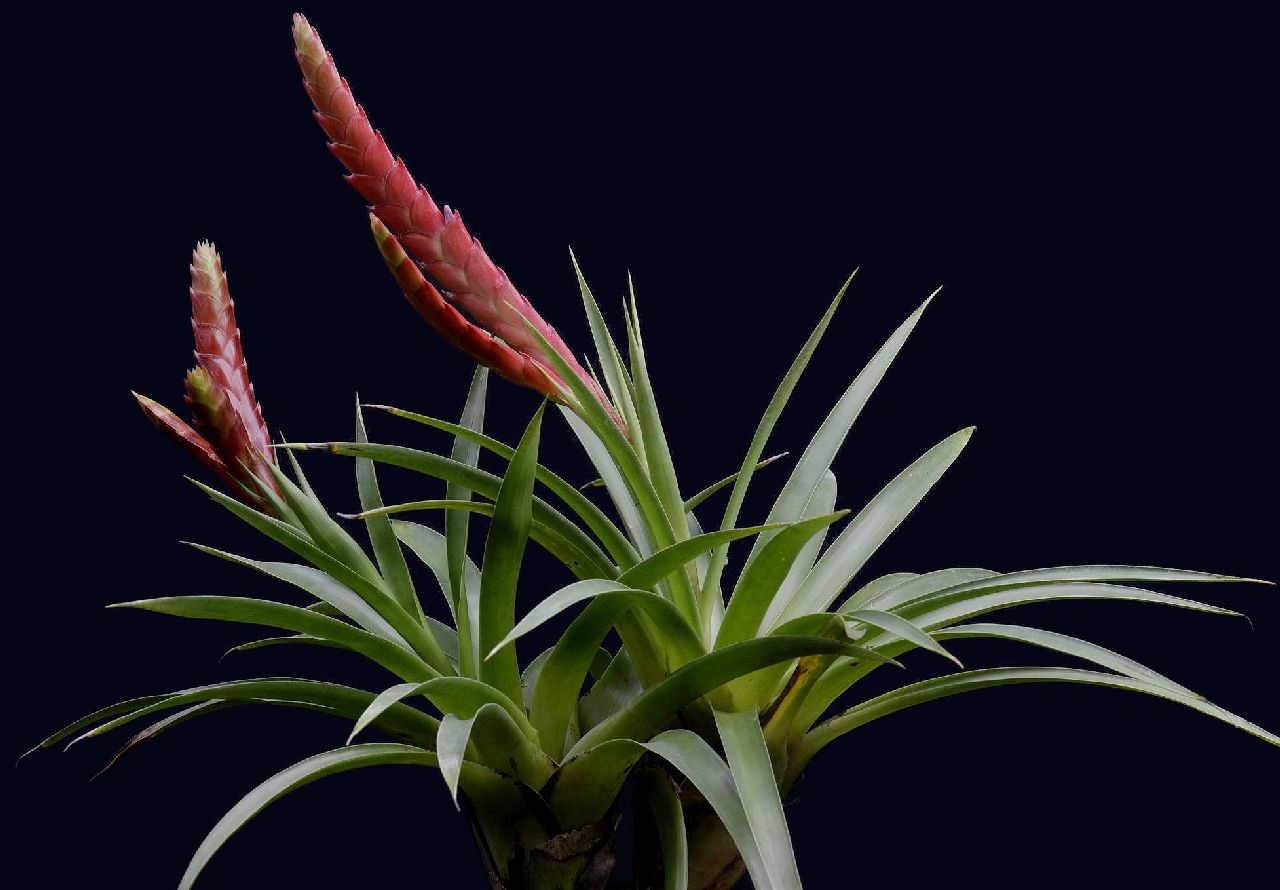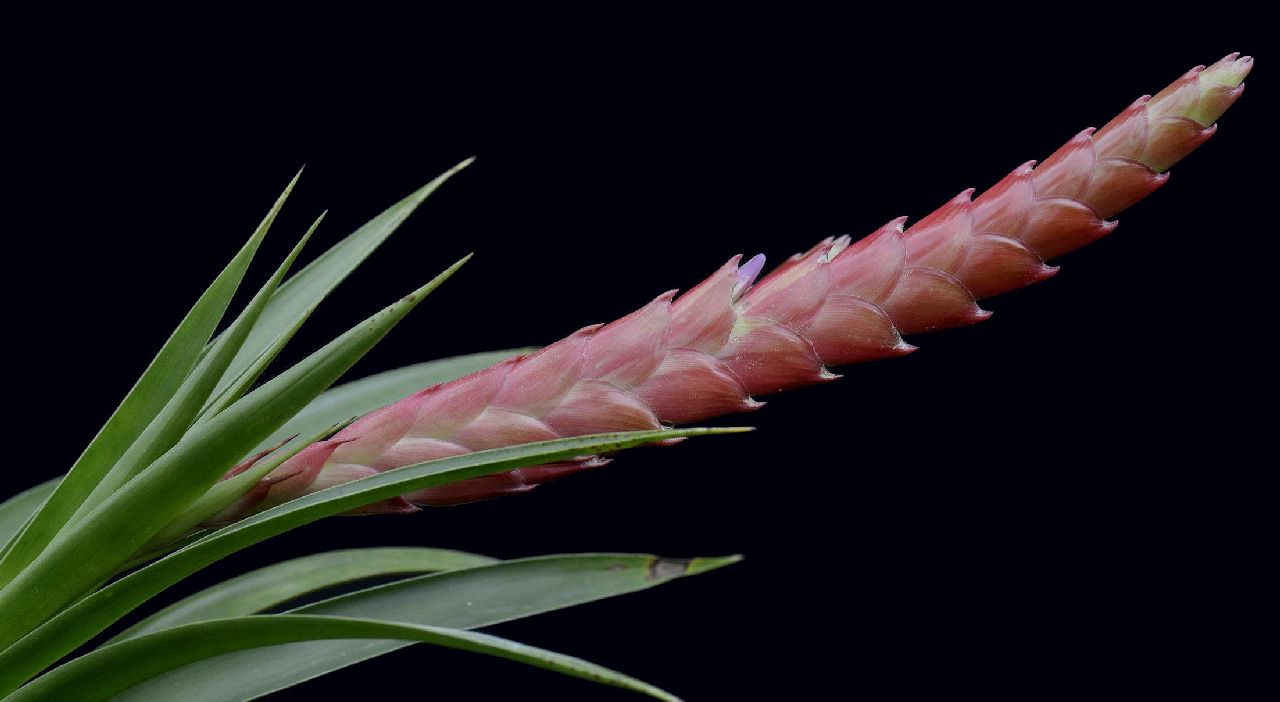



Tillandsia romeroi L B Smith var. gruberi Rauh Trop. Subtrop. Pflanzenwelt 60:77-82. 1987
A typo differt characteribus sequentibus:
Planta minor, florens usque ad 40 cm, nec usque ad 100 cm alta; vaginae foliorum supra in triente superiore profunde atroviolaceae; laminae in apicem pungentem excurrentes. Inflorescentia spicis plerumque duabus inaequilongis, rarius 1, 3 vel 5 erectis non divaricatis, non accurate complanatis, sed utrimque inflatis. Bracteae scapi superiores et bracteae primariae inferiores non lamina propria, sed tantum lamina brevi anguste lineari acuminata. Bracteae florales sepalis longiores, saepe strato cereo albo obtectae, congestae. Sepala posteriora valde carinata numquam ecarinata. Flores se non aperientes.
Holotypus: B.G.H. 55 154, leg Franz Georg Gruber, Nova Granada (1981), in herb. inst. system. bot. univ. heidelb. (HEID).
Patria et distributio: epiphytica in dumetis humilibus prope Bogotacito inter Duitam et Charala apud 1800-2000 m.s.m., Nova Granada orientali-centralis.
Translated by Derek Butcher
Differs from the Type in following characteristics:
Plant small, flowering only to 40 cm, not 100 cm high;
Leaf-sheaths upperside in the upper third profoundly dark violet;
Leaf blade ligulate tapering to a pungent tip.
Inflorescence usually with 2 unequally long, rarely 1, 3 or 5 upright, not spreading spikes;
Spikes not strictly complanate but inflated.
Scape bracts upper ones and lower
Primary bracts not laminate but only with a short, narrowly linear, pointed blade.
Floral Bracts as long as the sepals, abundantly covered with a white wax-layer, very densely erect.
Posterior sepals strongly carinate, not ecarinat.
Does not often flower.
DESCRIPTION
Plant stemless, flowering to 40 cm high.
Leaves numerous, forming a broad funnel-rosette to 25 cm high and, to 50 cm wide.
Sheaths wide-oval, distinct, to 9 cm long, 6 cm wide, upper side in the upper half deep dark-violet, the basal half light-brown, underneath light-brown with dark-violet edges, on both sides small appressed lepidote.
Blades narrow 3-angular to subligulate, approximately 30 cm long, the base with bend over edges, the upper half bent over, next to the sheath 4 cm wide, tapering to a 1 cm long, almost pungent tip, green, the upper third with abundant dark-violet spots, both sides with lax small, appressed lepidote.
Scape as short as the leaf-blades, to 15 cm long, 7 mm thick, green, round, upright, densely enclosed by green, subfoliate scape bracts;
Scape bracts similar to the upper primary bracts; the basal ones green, the upper ones with crimson sheath and short, green, sharp blade.
Inflorescence simple or with 2-5 digitate spikes.
Primary bracts similar to the upper scape bracts, with 3 cm long and 2 cm wide, pale-carmine red sheath and to 1 cm long, green, pungent blade, as long as the sterile base of the spike which is 1.5 cm long, flattened, green, with a base, keenly 2-keeled, pale reddish pedunle bracts.
Spike (with stalk) approximately 18 cm lang, 2.5 cm broad, acuminate, both sides strongly convex, ca. 20-flowered.
Floral bracts densely imbricate, strong, shiny crimson, covered partially with a white wax-layer, underneath only at the top, upper side scattered appressed lepidote, suborbicular, with a short, greenish, inwards bent, hard spiny tip, 3-3.5 cm long, 3 cm wide, keenly keeled, to the base whitish-green, exceeds the sepal.
Flowers subsessile, 3.8 cm long.
Sepals to 2.5 cm long, 0.8 cm wide, longlish-lanceolate, spiny tipped, the posterior ones carinate, connate for approximately 6 mm, greenish, violet tipped, both sides very scattered lepidote.
Petals to 3.2 cm long, narrow-tongue shape, with cucullate top, not opening at anthesis, approximately exceeding by 1 cm the floral bract, pale violet, white edges, at the base white, pale when dry.
Stamens enclosed.
Filament flat at the base and twisted, white, with 5 mm long, whitish anthers, approximately 3 mm shorter than the petals.
Style with papillosen stigma lobes as short as the stamens.
Ovary blunt-3-angular, 5 mm high.
Holotype: B.G.H. 55154, leg. Franz Georg GRUBER, Colombia (1981), in the Herb.. Inst. System. Bot.. Univ. Heidelberg (HEID).
Distribution: Epiphytic in low bushes near Bogota city, between Duitama and Charala, 1800-2000 m, central-east Columbia
The variety gruberi produces usually only 1 spike, sometimes 2, a larger one and a smaller one, but it can also produce up to 5 equally long spikes. In habitat the floral bracts are full with a slimy liquid.
The location of var. gruberi is approximately 600 km (as the crow flies) from the loacity for the Type var. romeroi.
SUMMARY - var. romeroi
Plant flowering to 1 m high;
Sheath to 15 cm long;
Inflorescence usually 4-spiked;
Spike complanate;
Sepals posterior pair usually ecarinate.
Habitat: North-Colombia, 2800 m.,
SUMMARY- var. gruberi Rauh
Plant flowering only to 40 cm high;
Sheath to 9 cm long, upperside in the upper half dark-violet;
Inflorescence digitate, with 1-5, usually 2 inflated spikes;
Floral bracts abundantly gray waxy;
Sepals posterior pair carinate.
Habitat: Central east Columbia, 1800-2000 m.,